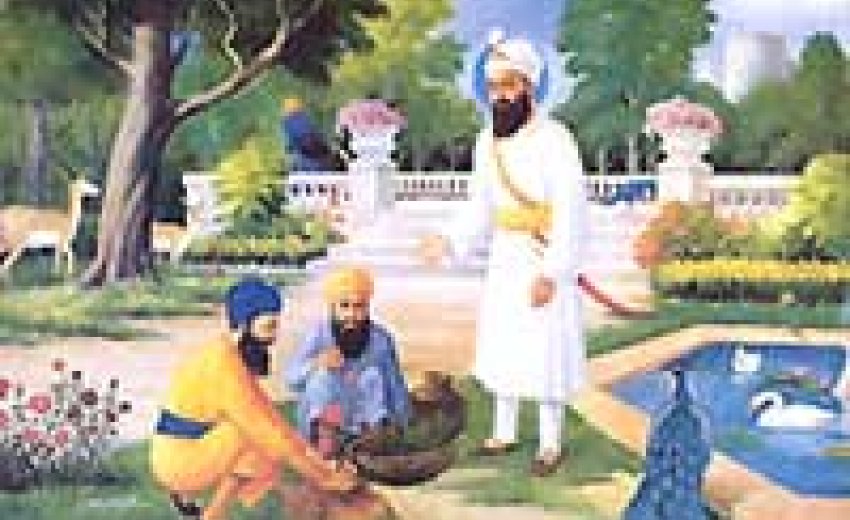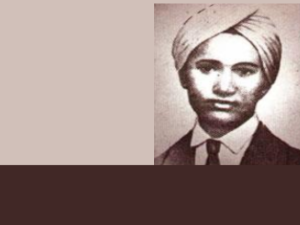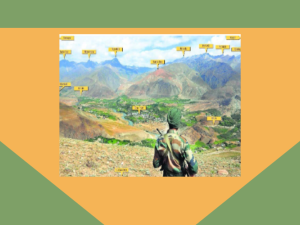 Originally published March 12th 2010
Originally published March 12th 2010
The Akal Takhat is the highest temporal and
spiritual body of Sikhs. On Sunday July 26, 2009, Jathedar Gurbachan
Singh the Head of the Akal Takhat made a public statement saying that
caring for the environment is the "moral
and religious duty" of a Sikh.
This is a welcome declaration of going green.
Speaking to
the community who had gathered for ongoing efforts at cleaning the
polluted Kali Bein, a river which runs through Sultanpur, the Jathedar
advised all Sikhs, "Wherever in
the world you may be, your focus should now be on cleaning up of natural
water resources rather than building Gurdwaras."
This is a great order given by the head of any religious body for
environment protections. It is extremely important; more so, when it is a
binding order. Kali Bein is the rivulet of Beas which had been polluted
by industrial waste and public refuse.
Sikh leader,
Baba Balbir Singh Seechewal, undertook to clean the rivulet with the
help of the people. He also created a green belt along the Bein River.
He created awareness among the masses about the protection of
environment. Taking a queue from these events the Head, Shiromani
Gurdwara Parbandhak Committee ordered that the Gurdwara should start
distributing trees in place of 'parsad' and this was literally followed.
This is a great change towards the protection of environment.
Sikh religious and political leaders from India and abroad met in New Delhi to underline the Sikh community's commitment to save the environment from threats posed by climate change and global warming. They met at an event titled EcoSikh Conclave, which was organized at India Habitat Center in New Delhi on July 4, 2009.
Guru Har Rai, the seventh Sikh Guru developed Kiratpur Sahib as a town of parks and gardens. Located on the banks of tributary of the Sutlej, he planted flowers and fruit bearing trees all over the area. This created a salubrious environment, attracting beautiful birds to the town and turning it into an idyllic place to live in.
In Sikh beliefs, a concern for the environment is part of an integrated approach to life and nature. As all creation has the same origin and end, humans must have consciousness of their place in creation and their relationship with the rest of creation. Humans should conduct themselves through life with love, compassion, and justice. Becoming one and being in harmony with God implies that humans endeavor to live in harmony with all of God's creation.
It is in this context that the Head Priest of Akal Takhat and President, SGPC have issued orders to all Sikhs to preserve nature and it is now binding on all the Sikhs that they must protect the environment. Sikhs have thus been bound to the duty of environment protection.
Those who attended and presented their
views were Union Cabinet Minister of India, Dr. Manohar Singh Gill,
Secretary, Shiromani Gurdwara Parbandhak Committee (SGPC), Dilmegh
Singh, President of Delhi Sikh Gurdwara Management Committee (DSGMC),
Paramjit Singh Sarna, Former Supreme Court Judge, Justice Kuldeep Singh,
MP Tarlochan Singh, and Vikram Singh Sahney of World Punjabi
Organization. They endorsed a five-year "greening" plan, which includes a long-term
commitment to transform Gurdwaras and schools into ecologically sound
buildings in terms of energy and the types of building material used,
besides incorporating environmental education into Sikh education
curricula.
Justice Kuldeep Singh, known as
'Green Judge', in his opening remarks, said he was delighted that Sikh
community was taking upon itself the noble service of forging
environment-friendly practices. "As
Sikhs we have a responsibility to revere the environment. A Sikh's life
is incomplete if he does not revere Nature,"
he said. "Environmental ethics
has always been an inherent part of India's precepts and philosophy and
the environment has always been given an honorable place," he said. "But
now we are only polluting it."Sikhs
have thus been bound to the duty of environment protection. Environment
refers to what makes up the atmosphere or background against which
someone or something is seen. Environment may refer either to actual
physical surroundings or to social or cultural background factors.
Environment is termed as the:
1. The circumstances or conditions that surround one; surroundings.
2. The totality of circumstances surrounding an organism or group of organisms, especially:
a. The combination of external physical conditions that affect and influence the growth, development, and survival of organisms. "We shall never understand the natural environment until we see it as a living organism" (Paul Brooks).
b. The complex of social and cultural conditions affecting the nature of an individual or community.
Earth, air, water, life and all activities connected with life come under the umbrella of environment.
saachay tay pavnaa bha-i-aa pavnai tay jal ho-ay.
jl qy iqRBvxu swijAw Git Git joiq smoie ]
jal tay taribhavan saaji-aa ghat ghat jot samo-ay. (SGGS Sri Raag, M.1, p.19)
Sri Guru Granth Sahib (SGGS), the supreme Sikh scripture states that the air originated from the True Lord; from air originated the water and from the water originated the entire universe; and in each being Lord's Light is enthused.
Thus air, water, earth and life all originated from the True Lord and the True Lord resides in each, in the form of light energy. When we harm any of these, we in turn harm the True Lord. Therefore, earth, air, water and life are all sacred for the Sikhs.
Every Sikh child learns along with Japuji, the Sikh sacred verse written by Guru Nanak, which starts with word "Ik Oankar" meaning there is the only One; the God, who is the creator the Karta Purukh of all. Here it includes the entire universe; the men, the animals, plants, the trees, the planets, the earths and the like. It also considers all to be belonging to the One and the same hence to be considered as equal. The One Creator pervades all creation.
AwpIn@Y Awpu swijE AwpIn@Y ricE nwau ]
aapeenHai aap saaji-o aapeenHai rachi-o naa-o.
duXI kudriq swjIAY kir Awsxu ifTo cwau ]
duyee
kudrat saajee-ai kar aasan ditho chaa-o. (SGGS, Asa di Var, p.463)
The early morning spiritual ballad, tells us that upon creating Himself (3), God created nam, the Divine name -the first expression of His sacred presence. Secondly, He created kudrat or nature, which is sustained and totally infused by nam. So, the Creator observes creation, and dwells within it. Both are interconnected. You will find this is something stressed especially by the eastern faiths. One cannot help but live in gratitude and respect for the gifts of nature which are marks of God's Grace.
balihaaree kudrat vasi-aa.
qyrw AMqu n jweI liKAw ]1] rhwau ]
tayraa ant na jaa-ee lakhi-aa. ||1|| rahaa-o. (SGGS p.469)
who dwells within nature and whose limits cannot be told.
Last lines of Japuji say:
pavan guroo paanee pitaa maataa Dharat mahat.
idvsu rwiq duie dweI dwieAw KylY sgl jgqu ]
divas raat du-ay daa-ee daa-i-aa khaylai sagal jagat. (SGGS p.8)
pa-un paanee Dhartee aakaas ghar mandar har banee. (SGGS p.723)
Air, water, earth and sky - the Lord has made these His home and temple.
The importance of Air, Water and Earth to life are emphasised over and over again in the Sri Guru Granth Sahib. The earth is referred to as the mother and as such requires our respect. Great care needs to be taken to ensure that no damage occurs to it while the Sikh is going about his or her daily life. The pollution of these 3 elements is against the principles laid down by the Gurus.
Having created this universe and the world, God directs them. All actions take place within God's Order (Hukam). God alone knows how and why. God, however, not only directs this vast and massive theater, but also watches over with care and kindness-the benign, supportive parent!
"Men, trees, pilgrimage places, banks of sacred streams, clouds, fields. Islands, spheres, universes, continents, solar systems, the sources of creation, egg-born, womb-born, earth-born, sweat-born, oceans, mountains and sentient being; He, the Lord, knows their condition, O Nanak. Having created beings, the lord takes care of them all. The Creator who created the world, He takes thought of it as well." (SGGS 466)
The world, like all creation, is a manifestation of God. Every creature in this world, every plant, every form is a manifestation of the Creator. Each is part of God and God is within each element of creation. God is the cause of all and He is the primary connection between all existences.
"The Creator created himself... And created all creation in which He is manifest. You Yourself are the bumble-bee, flower, fruit and the tree. You Yourself the water, desert, ocean and the pond. You Yourself are the big fish, tortoise and the Cause of causes. Your form cannot be known." (SGGS 1016)
In the world God has created He has also provided each species and humans with means of support and nurturing.
Kwk nUr krdM Awlm dunIAwie ]
khaak noor kardaN aalam dunee-aa-ay.
Asmwn ijmI drKq Awb pYdwieis Kudwie ]1]
asmaan jimee darkhat aab paidaa-is khudaa-ay.
||1|| (SGGS p.723)
The Lord infused His Light into the dust, and created
the world, the universe.
The
sky, the earth, the trees, and the water - all are the Creation of the
Lord. (1)
nrnrh nmskwrM ]
narnarah
namaskaaraN.
jln Qln bsuD ggn eyk eykMkwrM ]1] rhwau ]
jalan
thalan basuDh gagan ayk aykaNkaaraN. ||1|| rahaa-o.
(SGGS p.901)
I humbly bow
to the Lord, the Supreme Being.
The
One, the One and Only Creator Lord permeates the water, the land, the
earth and the sky. ((1)(Pause))
Guru Nanak considered no difference between the created and the creature; the nature and God and saw God in the nature itself. If he would have seen how today's world is polluting the nature, he really would have wondered at the change towards the negative.
Rabindra Nath Tagore was so impressed by description of relationship of nature and God given in the hymn "Aarti" that he described it as the best piece of poetry he has read ever.
gagan mai thaal rav chand deepak banay taarikaa mandal janak motee.
DUpu mlAwnlo pvxu cvro kry sgl bnrwie PUlµq joqI ]1]
Dhoop mal-aanlo pavan chavro karay sagal banraa-ay foolant jotee. ||1||
kYsI AwrqI hoie ] Bv KMfnw qyrI AwrqI ]
kaisee aartee ho-ay. bhav khandnaa tayree aartee.
Anhqw sbd vwjMq ByrI ]1] rhwau ]
anhataa sabad vaajant bhayree. ||1|| rahaa-o.
shs qv nYn nn nYn hih qoih kau shs mUriq nnw eyk quohI ]
sahas tav nain nan nain heh tohi ka-o sahas moorat nanaa ayk tohee.
shs pd ibml nn eyk pd gMD ibnu shs qv gMD iev clq mohI ]2]
sahas pad bimal nan ayk pad ganDh bin sahas tav ganDh iv chalat mohee. ||2||
sB mih joiq joiq hY soie ]
sabh meh jot jot hai so-ay. (SGGS, p.13)
In the sky's salver, the sun and the moon are lamps and the stars with their orbs are the studded pearls.
The fragrance of sandalwood makes Your (God's) incense;
wind makes Your fan and all the vegetation Your flowers, O Luminous Lord!
What a beautiful worship with lamps is being performed?
This is Your present adoration: the Remover of the fear!
The celestial strain is the sounding of the temple drums (pause).
Thousands are Your eyes, yet You have no eyes; Thousands are Your forms; yet You have no form;
Thousands are Your feet yet You have no feet; Thousands are your noses; yet You have no nose.
By your Light, the Light shines within all the souls.
What a wonderful description of the Creator and His relationship with his Creation! The hymn describes the greatness of the nature of the True Lord which performs prayer-worship to the God. He compares the sky to a platter in which son and moon are the lighting pearls. The sunshine enlightens the entire atmosphere and the air moves to remove any unwanted pollution, the entire natural creation appears as spread out light. This is how the real prayer to the God is done.
Guru Nanak's deep love with the nature creates his link to the God and takes one to sublime heights. During his itineraries world over; where ever he went he established himself under a tree in a nearby jungle and did not prefer to stay in any constructed house as can be seen in the pictures below.
1.
Guru Nanak under a tree with a peacock perched on it. 2. Guru Nanak is
seen with his companions Bala and Mardana under a tree.
Two peacocks are shown in the
background 3.Guru Gobind Singh is shown composing poetry under a tree.
In the first two pictures Guru Nanak is shown under the shade of a tree and peacocks in the background. Even Guru Gobind Singh preferred composing his poetry under a tree as can be seen in the picture on the right.






